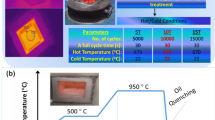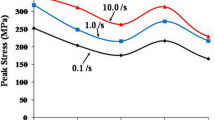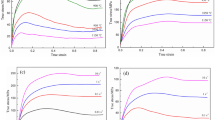Abstract
Axial closed-die rolling (ACDR), as a new type of local loading and labor-saving forming method, has a broad application prospect in the production of large-scale rotary parts, compared with traditional upsetting forming. However, the different evolutions of thermal and mechanical parameters and microstructure between the two forming modes are still ambiguous. In this study, the thermal and mechanical parameters and microstructure evolutions of 30Si2MnCrMoVE UHSS after ACDR and upsetting deformation were studied by means of numerical simulation, metallographic observation, and scanning electron microscope (SEM). The temperature and effective strain evolution of the upper surface, central axis, and middle height (1/2h) of the workpiece were analyzed by numerical simulation. Combined with the evolution of temperature and equivalent strain, the mechanisms of original austenite microstructure evolution of the two deformation modes were analyzed. The results show that there is only one deformation dead zone at the lower end of the workpiece after ACDR deformation which is different from upsetting. The deformation temperature is the primary reason for the difference of microstructure evolution at 1/2h between ACDR and upsetting deformation. The microhardness at 1/2h of the sample after ACDR deformation and direct quenching is lower than that of upsetting.













Similar content being viewed by others
Availability of data and materials
All data generated or analyzed during this study are included in this published article.
References
Marczinski HJ (1992) Axial closed-die rolling, an economic hot-forming method due to high precision and flexibility. J Mater Process Technol 34:495–502
Han X, Hua L (2009) Comparison between cold rotary forging and conventional forging. J Mech Sci Technol 23:2668–2678
Zheng Y, Liu D, Yang YH, Li XL (2018) PDZ evolution of hot ACDR and forging processes during titanium alloy disc forming. Int Adv Manuf Technol 95:1635–1643
Zheng Y, Liu D, Yang YH, Ren LJ, Zhang Z (2016) Investigation on metal flow during the hot axial closed die rolling process for titanium alloy discs. Int J Adv Manuf Technol 87:1–14
Choi S, Na KH, Kim JH (1997) Upper-bound analysis of the rotary forging of a cylindrical workpiece. J Mater Process Technol 67:78–82
Oh HK, Choi S (1997) A study on center thinning in the rotary forging of a circular plate. J Mater Process Technol 66:101–106
Samołyk G (2013) Investigation of the cold orbital forging process of an AlMgSi alloy bevel gear. J Mater Process Technol 213:1692–1702
Hua L, Han X (2009) 3D FE modeling simulation of cold rotary forging of a cylinder workpiece. Mater Des 30:2133–2142
Han X, Hua L (2009) 3D FE modeling of cold rotary forging of a ring workpiece. J Mater Process Technol 209:5353–5362
Zheng Y, Liu D, Zhang Z, Yang YH, Ren LJ (2017) The flow line evolution of hot open ACDR process for titanium alloy discs. Arch Civ Mech Eng 17:827–838
Zheng Y, Liu D, Qiu SY, Wang SZ, Wei LF, Wang ZM, Tian DR (2019) Effect of deformation routes on torsion behavior via ACDR process. Int J Adv Manuf Technol 104:4105–4116
Zheng Y, Liu D, Yang YH, Zhang Z, Li XL, Zhang RQ (2017) Microstructure evolution of Ti-6Al-4V with periodic thermal parameters during axial closed die rolling process. J Alloys Compd 735:996–1009
Wang H, Liu D, Wang JG, Wang HP, Hu Y, Rao HD (2020) Characterization of hot deformation behavior of 30Si2MnCrMoVE low-alloying ultra-high-strength steel by constitutive equations and processing maps. J Iron Steel Res Int :1-13.
Swarr T, Krauss G (1976) The effect of structure on the deformation of as-quenched and tempered martensite in an Fe-0.2 pct C alloy. Metall Trans A 7:41–48
Xu P, Yu JM, Zhang ZM (2019) Microstructure and texture evolution of Mg-Gd-Y-Zn-Zr alloy by compression-torsion deformation. Materials 12:2773
Valiev RZ, Ivanisenko YV, Rauch EF, Baudelet B (1996) Structure and deformaton behaviour of Armco iron subjected to severe plastic deformation. Acta Mater 44:4705–4712
Cižek J, Janecek M, Krajňak T, et al (2016) Structural characterization of ultrafine-grained interstitial-free steel prepared by severe plastic deformation. Acta Mater: 258-272.
Dehghan-Manshadi A, Barnett MR, Hodgson PD (2008) Recrystallization in AISI 304 austenitic stainless steel during and after hot deformation. Mater Sci Eng A 485:664–672
Zhang FX, Liu D, Yang YH, Liu CX, Zhang Z, Wang H, Wang JG (2020) Investigation on the meta-dynamic recrystallization behavior of Inconel 718 superalloy in the presence of delta phase through a modified cellular automaton model. J Alloys Compd 817:152773
Morito S, Yoshida H, Maki T, Huang X (2006) Effect of block size on the strength of lath martensite in low carbon steels. Mater Sci Eng A 438:237–240
Funding
This work was supported by the Fundamental Research Funds for the Central Universities (Program No. 3102019ZX004), Natural Science Basic Research Program of Shaanxi (No.2020JQ-182), and Natural Science Foundation of Chongqing, China (Program No. cstc2020jcyj-msxmX0046).
Author information
Authors and Affiliations
Contributions
Hai Wang and Zhe Zhang carried out numerical simulations and experiments. Dong Liu and Yanhui Yang designed the experiment and simulation scheme. Fuxiang Zhang and Jianguo Wang analyzed the simulation and experimental data.
Corresponding author
Ethics declarations
Ethics approval and consent to participate
Not applicable.
Consent for publication
Not applicable.
Competing interests
The authors declare no competing interests.
Additional information
Publisher’s note
Springer Nature remains neutral with regard to jurisdictional claims in published maps and institutional affiliations.
Rights and permissions
About this article
Cite this article
Wang, H., Liu, D., Zhang, F. et al. A comparative study on the evolutions of thermal and mechanical parameters and microstructure of 30Si2MnCrMoVE steel during hot ACDR and upsetting deformation. Int J Adv Manuf Technol 114, 579–589 (2021). https://doi.org/10.1007/s00170-021-06894-x
Received:
Accepted:
Published:
Issue Date:
DOI: https://doi.org/10.1007/s00170-021-06894-x




